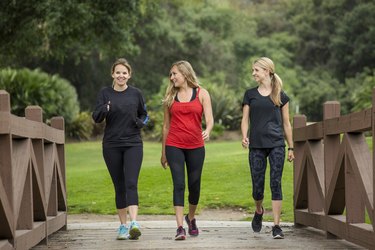
Walking is hands-down the easiest form of exercise. So easy, in fact, that you likely do it without even thinking about it. You can walk almost anywhere, and walking provides a broad range of benefits. Unfortunately, researchers and health experts agree that Americans need to be doing a lot more of it.
In a 2010 study published in Medicine & Science in Sports & Exercise, researchers used pedometers to track the steps of 1,136 American adults. The findings revealed that Americans take fewer steps than adults in Australia, Switzerland and Japan.
Video of the Day
Video of the Day
All three countries also have fewer cases of obesity and heart disease than the U.S. does — unsurprising, considering how walking can affect your physiology. Learning more about these benefits might inspire you to take some important steps toward long-term fitness.
While power walking may burn more calories over the same period of time as regular walking, we still see the significant health benefits with regular walking.
—John M. Martinez, M.D., sports and family medicine physician at Kaiser Permanente in San Diego, Calif.
The Health Benefits of Walking
For starters, walking is a low-impact activity and doesn't place a ton of stress on your body the way running, jumping or even dancing can. That makes it ideal for aging adults, people prone to joint pain and anyone hoping to transition from a sedentary to a more active lifestyle. It also gets your heart beating faster and can help strengthen and tone your muscles.
"Walking works large muscle groups — quadriceps, hamstrings, gluteal muscles — as well as other muscles in the lower legs and feet," says Joanne DiFrancisco-Donoghue, a registered clinical exercise physiologist with the New York Institute of Technology College of Osteopathic Medicine.
DiFrancisco-Donoghue says that working these muscles improves circulation, increases cardiovascular endurance, boosts bone health and reduces obesity and the risk of diabetes. Routine walking can also lower your LDL, or "bad" cholesterol, and boost your HDL, or "good" cholesterol, while improving your weight, overall fitness and mood.
If you walk outdoors, you'll reap the added benefit of vitamin D, a nutrient Americans often lack that your body synthesizes in response to sun exposure. That's important because vitamin D could provide protection from osteoporosis, high blood pressure and cancer.

Reduce Obesity Risk by Increasing Pace
Adding a little pep to your step might also kick up walking's benefits. A 2012 study published in the journal BMJ Open showed that intense walking for two to four hours a week slashed participants' risk of diabetes, heart disease and metabolic syndrome — an obesity-related group of conditions — by 50 percent.
The researchers, who analyzed the exercise habits and health of 10,000 adults in Denmark for a decade, found that exercise intensity matters more than total time of exercising. Brisk walking also curbed participant appetite, which is important for reaching and maintaining a healthy weight.
If you're daunted by imagining hip-swiveling racewalkers moving at near runners' speed, you can breathe easy. "While power walking may burn more calories over the same period of time as regular walking, we still see the significant health benefits with regular walking," John M. Martinez, M.D., sports and family medicine physician at Kaiser Permanente in San Diego, Calif.
The 2018 Physical Activity Guidelines for Americans, 2nd Edition, distributed by the Centers for Disease Control and Prevention (CDC), recommends that adults aim for 150 to 300 minutes of moderate intensity aerobic exercise, such as brisk walking, or 75 to 150 minutes of vigorous aerobic exercise, such as race walking, every week for optimum health.
One way to determine whether you've reached moderate intensity is the "talk test." During moderately intense activity, you should be able to talk but not sing, according to the CDC. During vigorous activity, you'll be able to say only a few words before breaking to breathe.
You can also assess intensity by time and distance. Brisk walking will take you three miles or more per hour. For more specific analyses, a personal trainer or physician can assist you in determining your ideal pace using a heart-rate monitor.
Read more: 6 Ways to Burn More Calories by Walking

Incorporate Walking Into Your Daily Routine
Getting started can be the toughest part of exercise regimen, as it requires changes in your routine, the desire to get up and go and added use of your muscles and energy. Establishing a game plan can help ensure success.
"I have patients write down a specific time each day that is their exercise time and add it to their to-do list," Dr. Martinez says. He also recommends walking with a partner, tracking your activity and if you're older or previously sedentary, walking during TV commercial breaks.
DiFrancisco-Donoghue recommends starting out with a stopwatch and pedometer, which counts your steps and analyzes your distance by detecting motion. "Start with 10 to 15 minutes of walking each day," she says.
"Don't walk 30 minutes right away, because this will lead to overuse injuries and can also be discouraging if you are not able to complete the session." She recommends adding five minutes each week until you've reached your goal.
Read more: The 10,000 Steps a Day Challenge
Take Your Exercise Beyond Walking
Walking might be all your body needs to reach and maintain physical fitness if you routinely walk far enough and at an effective pace. Once the exercise seems easy — meaning you barely break a sweat or stop noticing any physical improvement — increasing your distance, frequency or intensity can help.
Even if walking seems sufficient, you may decide to branch out and try other forms of exercise. "Walking is an easy introduction into the world of exercise and fitness," Dr. Martinez says. "Patients that start off with a simple walking program, and then continue on to more intense exercise programs such as yoga, running half-marathons and even a few that have completed Ironman triathlons."
Attempting to reduce his 280 pounds of body weight, one of Martinez's former patients began taking short walks around his workplace. Once he gained stamina and shed excess pounds, he took up jogging, swimming and cycling. He's lost 100 pounds and is now an Ironman triathlete.
"Without taking those first few steps to walk none of the rest of his accomplishments would have been possible," Dr. Martinez says.
Bottom line: Walking alone might not be solution to the obesity epidemic in America, but it most certainly is a step in the right direction.

5 Ways to Make Walking More Fun and Effective
If you don't enjoy an activity, it's unlikely that you'll stick with it. Even if you persevere, misery isn't a helpful workout motivator. To enhance the fun factor and stay active long-term, consider the following:
Walk to music. Walking to upbeat music can kick things up a notch. Denise Miccoli Trent, fitness coach and educator, suggests creating playlists the length of your desired workout. Rather than focusing on the clock, which can be tedious, you can enjoy your music (or podcast!) until your workout is complete. Limit music while walking in heavy traffic areas, however, which poses safety risks.
Try a walking app. If you enjoy all things tech-related, Dr. Martinez suggests using a smartphone app. Such apps can track your progress to see how far you've gone. Seeing the data as you reach your goals can instill a sense of accomplishment.
Take short walks after meals. A refreshing 5- to 10-minute walk after eating can help prevent overeating during your meal and post-meal snacking, as you won't want to walk with a stuffed belly. It can also reduce your triglyceride levels and improve digestion, says DiFrancisco-Donoghue.
Choose quality gear. While walking doesn't require fancy equipment, Dr. Martinez recommends wearing high-quality shoes. Walking-specific shoes that fit well promote safety, comfort and proper technique. Wear comfortable workout apparel in styles and colors you like.
Walk a dog. A 2011 study at Michigan State University of 5,900 adults, including 2,710 dog owners, showed that 60 percent of participants who walked their dogs met standard recommended exercise needs. Only one-third of people who didn't walk dogs demonstrated similar fitness. Don't have a dog of your own? Volunteer to walk the pups at a local animal shelter!
- Medicine & Science in Sports & Exercise: Pedometer-Measured Physical Activity and Health Behaviors in U.S. Adults
- BMJ Open: Intensity versus duration of physical activity: implications for the metabolic syndrome. A prospective cohort study
- 2018 Physical Activity Guidelines for Americans, 2nd Edition
- The New York Times: What Do You Lack? Probably Vitamin D
- Journal of Physical Activity and Health: The impact of dog walking on leisure-time physical activity: results from a population-based survey of Michigan adults.
- Mayo Clinic: Walking: Trim Your Waistline, Improve Your Health